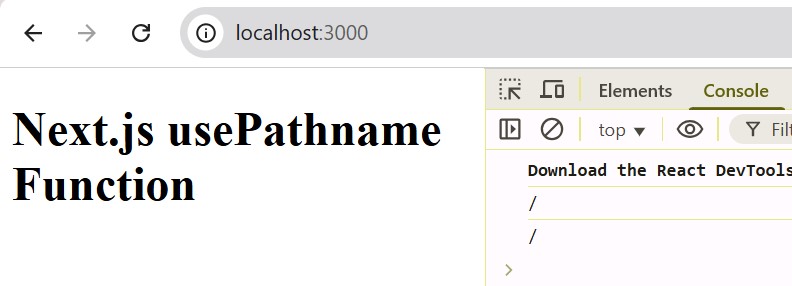
- Next.js - Home
- Next.js - Overview
- Next.js - Project Setup
- Next.js - Folder Structure
- Next.js - App Router
- Next.js - Page Router
- Next.js Features
- Next.js - Pages
- Next.js - Data Fetching
- Next.js - ISR
- Next.js - Static File Serving
- Next.js - Pre-Rendering
- Next.js - Partial Pre Rendering
- Next.js - Server Side Rendering
- Next.js - Client Side Rendering
- Next.js Routing
- Next.js - Routing
- Next.js - Nested Routing
- Next.js - Dynamic Routing
- Next.js - Parallel Routing
- Next.js - Imperative Routing
- Next.js - Shallow Routing
- Next.js - Intercepting Routes
- Next.js - Redirecting Routes
- Next.js - Navigation and Linking
- Next.js Configuration
- Next.js - TypeScript
- Next.js - Environment Variables
- Next.js - File Conventions
- Next.js - ESLint
- Next.js API & Backend
- Next.js - API Routes
- Next.js - Dynamic API Routes
- Next.js - Route Handlers
- Next.js - API MiddleWares
- Next.js - Response Helpers
- Next.js API Reference
- Next.js - CLI Commands
- Next.js - Functions
- Next.js - Directives
- Next.js - Components
- Next.js - Image Component
- Next.js - Font Component
- Next.js - Head Component
- Next.js - Form Component
- Next.js - Link Component
- Next.js - Script Component
- Next.js Styling & SEO
- Next.js - CSS Support
- Next.js - Global CSS Support
- Next.js - Meta Data
- Next.js Advanced Topics
- Next.js - Error Handling
- Next.js - Server Actions
- Next.js - Fast Refresh
- Next.js - Internationalization
- Next.js - Authentication
- Next.js - Session Management
- Next.js - Authorization
- Next.js - Caching
- Next.js - Data Caching
- Next.js - Router Caching
- Next.js - Full Route Caching
- Next.js - Request Memoization
- Next.js Performance Optimization
- Next.js - Optimizations
- Next.js - Image Optimization
- Next.js - Lazy Loading
- Next.js - Font Optimization
- Next.js - Video Optimization
- Next.js - Script Optimization
- Next.js - Memory Optimization
- Next.js - Using OpenTelemetry
- Next.js - Package Bundling Optimization
- Next.js Testing
- Next.js - Testing
- Next.js - Testing with Jest
- Next.js - Testing with Cypress
- Next.js - Testing with Vitest
- Next.js - Testing with Playwright
- Next.js Debugging & Deployment
- Next.js - Debugging
- Next.js - Deployment
- Next.js Useful Resources
- Next.js - Interview Questions
- Next.js - Quick Guide
- Next.js - Useful Resources
- Next.js - Discussion
Next.js - usePathname() Function
The usePathname() Function
The Next.js usePathname() function is used to access the current URL path of the page. This function is only available in the client-side.
Syntax
The syntax for the usePathname() function is as follows:
'use client'
import { usePathname } from 'next/navigation'
const pathname = usePathname()
Parameters
The usePathname() function does not accept any parameters.
Return Value
The usePathname() function returns a string representing the current URL path of the page.
| URL | Returned value |
|---|---|
| / | '/' |
| /dashboard | '/dashboard' |
| /dashboard?v=2 | '/dashboard' |
| /blog/hello-world | '/blog/hello-world' |
Example 1
In the example below, we are using the usePathname() function to access the current URL path of the page and display it in the console.
'use client'
import { usePathname } from 'next/navigation'
export default function ExampleClientComponent() {
const pathname = usePathname()
console.log(pathname)
return (<h1>Next.js usePathname Function</h1>)
}
Output

Example 2
In the example below, we are using the usePathname() function to access the current URL path of the page and display it in the current page itself.
'use client'
import { usePathname } from 'next/navigation'
export default function ExampleClientComponent() {
const pathname = usePathname()
return (
<div>
<h1>Current URL path: {pathname}</h1>
</div>
)
}
Output

Advertisements